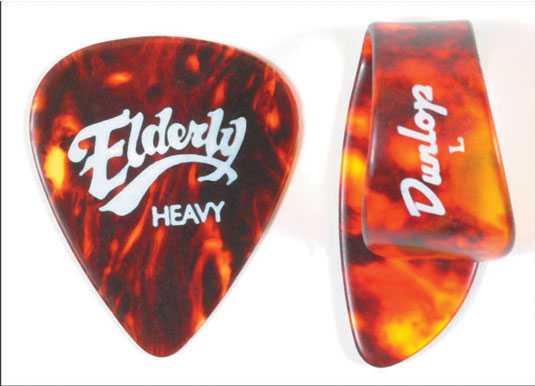Bluegrass banjo players use metal fingerpicks on their right-hand index and middle fingers and a plastic thumbpick on their thumb. Initially, you may find that getting used to the feel of these picks is a struggle. It may feel like you're wearing a coat of armor over the ends of your fingers, and you may hear a lot of scratchy sounds when you first start to play.
However, just about everyone gets used to the feel of the picks after a few weeks, and you'll appreciate the extra volume, speed, and drive that the picks lend to your playing. A visit to a music store can reveal numerous kinds of picks available for the thumb and fingers.
A thumbpick consists of a flat striking surface and a bent section that wraps the pick around the thumb. Most players prefer thumbpicks made from plastic, but a few players prefer the fit and sound of a metal thumbpick.
Increasingly, many bluegrass players are using thumbpicks with a polymer blade attached to a metal band. In any case, choose a thumbpick that fits as snugly as possible, with the blade facing in toward your right-hand fingers.
Don't mistake a thumbpick for the more common flatpick, which is a pick used by guitarists and mandolin players. A flatpick is held in the right hand by the thumb and fingers. You can see the difference between the two in this Figure. Don't be afraid to ask a music store employee or fellow musician to lead you in the direction of the thumbpicks.

Thumbpicks come in different sizes, thicknesses, and striking surface (blade) angles, so try as many different brands as you can to see what feels most comfortable to you. If you're like most players, you'll end up trying many different kinds of thumbpicks, and your preferences will change as time goes on, which is perfectly fine.
As in so many other aspects of banjo playing, you can't find one right answer. However, many professional players prefer a thumbpick that isn't too thin and doesn't have too short of a blade.
![Comparing different kinds of thumbpicks. [Credit: Photograph courtesy of Elderly Instruments]](https://www.dummies.com/wp-content/uploads/417925.image1.jpg)
As you fit the thumbpick onto your thumb, don't push it too far up your thumb — about halfway between the first joint and the end of your thumb is about right for most players (you can check out this placement in the Figure).
![Proper placement of a thumbpick on the right-hand thumb. [Credit: Photograph by Anne Hamersky]](https://www.dummies.com/wp-content/uploads/417926.image2.jpg)
If your thumb is too small for your favorite pick to fit tightly, don't be afraid to add surgical or duct tape to the inside of the pick to make it fit more snugly.
Some players even place their thumbpick in boiling water for a few seconds to soften the plastic. You can then shape the pick to fit tighter after carefully removing the pick from the water. (Just don't fetch the pick out of the water with your hands!)
At prices around $1 to $4, plastic thumbpicks aren't expensive, so go ahead and purchase a bunch of different kinds to see which one suits your playing best. Look for thumbpicks by Dunlop, Golden Gate, National, Propik, and Zookies, for good sound and playability. Blue Chip is the Rolls Royce of the premiere polymer-based thumbpicks, and if you're willing to spend the big bucks (around $35 each), you'll be picking in style.

